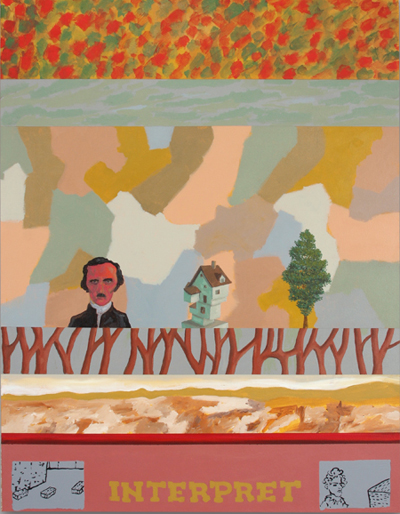swifts & s l o w s · a quarterly of crisscrossings
Assume Nothing
Ron Morosan & Daniel Barbiero
← back or home→
Anonymous as pure archetypes are. Give them names: Aristophanes and Sophocles. Mask of comedy. Mask of tragedy. Grease paint, rouge, conical cap and battered boater. Comedy hiding nothing it doesn’t double. The smile covering the smile, happy rictus because it’s always the others who suffer its bite, just like it’s always the others who die. The clown’s mask of tragedy may be on the wrong face—there may be some confusion here, a mix-up in the prop room—or is this tragedy returning as farce, Ajax falling on Hector’s sword after slipping on a banana peel? The tragic mask itself also covers a smile, the smile that sees black humor in the downfall, laughs at Socrates in the clouds because one knows how Socrates ends up. Tragedy gets the last laugh—the hollow wink and grin, revealing the clown beneath the skull. Two clowns. Pure archetypes. The white sphinx and the black sphinx. The one with the riddle. The other with the punchline no one wants to hear, or the long set-up that goes nowhere, and that nowhere is the entire point. Two clowns, two poles of a magnet, a coin with two reverses—toss it and know how it comes out, but assume nothing.
Interpret Poe’s forest reverie. Not the reverie itself, but rather the trees. Strip the mist off of them and find that their branches and trunks abut and interlace and spell out “whywhywhy” in a long sequence, a closed circle reaching back on itself from start to finish. A forest of signs, before Baudelaire came up with the phrase. “Why” is not a question so much as the hint of the answer, an expletive beginning the sentence that announces it. Poe lying on the ground and drawing his dream from the earth, recapitulating the earliest oracles read from the rustling of trees; his Island of the Fay becomes the forest of Dodona where the oak speaks when the wind moves through the branches and the trunk creaks. Interpret is to transpose. Refigure Orpheus into Usher. Read pronouncements into a Gothic tracery of branches and twigs. Fill in the missing letters surrounding the epsilon at Delphi with an asemic arabesque.
Three faces. Three figures. Light. Object rightly known. The shadow. Reverse them, and the sensible turned intelligible turns imaginary. Or, from the alembic of the imagination, fired as an image of the sun, emerges the gold of truth, also in the image of the sun. Which leaves right knowledge of the object, now recast as plausible opinion, as silver, and the shadow as lead. One needs to know these things. The first figure, rightmost, thinks the middle figure, who informs the leftmost. They replicate the history of thought, in an endless loop. Three hypostases recast as the chorus in a comedy, chasing each other and none of them ever quite overcoming the others. Trace a path of descent, a gradual dilution of light, color and morphology. Silenus held in check by aporia. A path of downward emanation, a nesting of categories and orders, a weakening into partial truths and imperfect axioms. Truth comes in iterations. Each new member a faded copy of the one before.
Paintings by Ron Morosan. Text by Daniel Barbiero.
← back or next →
Ron Morosan is an artist, writer, and curator. He has shown his work internationally at the American Pavilion of The Venice Biennale and the Circulo De Bellas Artes in Madrid, Spain. In the US he has shown at the New Museum and had a one-person exhibition at the New Jersey State Museum, and at numerous galleries in New York. He curated the Robert Dowd exhibition, Subversive Pop, at Center Galleries in Detroit, as well as Denotation, Connotation, Implication at Eisner Gallery, City University of New York. He has written catalogues for many artists, including Enid Sanford, Tom Parish, Robert Dowd, and others. In the 1990’s he started and ran B4A Gallery in Soho, New York, writing press releases, articles, and catalogues.
Daniel Barbiero is a double bassist, sound artist and composer active in improvised and experimental music and dance in the Baltimore-Washington area since the early 2000s. His music is inspired by the chromatic vocabulary, open-form compositional structures, and extended performance techniques of mid-20th century Modernism. He also writes regularly on music and other arts.



